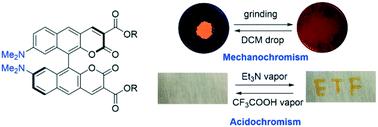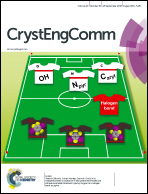Dimethylamine substituted bisbenzocoumarins: solvatochromic, mechanochromic and acidochromic properties†
Abstract
Stimuli-responsive luminescent materials have attracted considerable attention in recent years because of their potential application in various fields. In this work, dimethylamine substituted bisbenzocoumarin (DB-Cn) derivatives are synthesized and their optical properties are investigated. These molecules show solvatochromic and mechanochromic properties. Powder wide-angle X-ray diffraction and differential scanning calorimetry curves reveal that the initial crystalline states are transformed to amorphous states under various external stimuli. Single crystal X-ray analysis of DB-C2 reveals that the destruction of the crystal conformation and the changes of intermolecular π–π stacking interactions could be responsible for the red-shifted emission. Further investigation revealed that DB-C2 showed acidochromic properties and could be utilized as a security ink. The control 1H NMR experiment reveals that the protonation of the aromatic amines is essential for the acidochromic properties. This work provides information on the mechanism study of stimuli-responsive luminescence properties of binaphthalene-type luminescent materials and expands the potential application of these materials.



 Please wait while we load your content...
Please wait while we load your content...